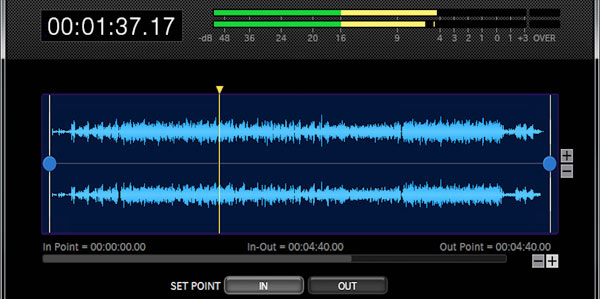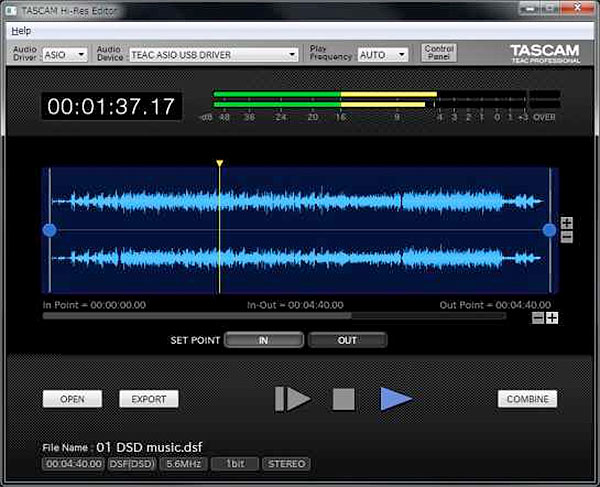A Voice In The Wilderness? Meh…
Today is DSD day. Sometimes the stars align and a topic appears magically from thin air. My friend Ray Kimber (yes, the guy behind the Kimber Kable company) posted an item on my FB feed announcing, “TASCAM Releases FREE HI-RES Audio Editor”. You can read the piece at ASKAudio.com by clicking here. Written by Rounik Sethi, it’s basically a press release about their “Hi-Res Editor”, which is described as, “a free application that supports up to 11.2MHz DSD files or 384k WAV. The software allows playback and export of DSD files without intermediate conversion to PCM audio.”
It’s a simple editor that will split an/or combine native DSD files. While it works on PCM WAV files up to 384/32-bit (there they are again…the stupid big spec numbers), the thing that makes this piece of free software worthy is that it “is one of the only ways to edit native DSD master recordings.” The other methods…Merging Technologies’ Pyramix and Sony’ Sonoma systems are hugely expensive. Lots of companies like TASCAM, KORG, and SONY make DSD recorders, there’s not a lot of editing systems around that will let you do any post production on the DSD native recordings.
Figure 1 – The simple interface for the “Hi-Res Editor” freeware from TASCAM. You IN and OUT and you slice.
The other catalyst for revisiting DSD was an email from Jeffrey Barish of 3Beez, a Colorado company that makes “WAX” a very highly regarded music management system. He wrote me about a piece he authored on their website called, “DSD support in WAX”. I guess he was inspired by the 530 comments posted on the Computer Audiophile site recently after I wrote that 96 kHz/24-bit PCM is better than DSD. He asked if I feel like a “voice in the wilderness”. The answer is yes I do…but only sometimes. Some of the smartest people I know are out here in the wilderness with me including the inventors of the MQA system and the programmer behind Amarra and the designer of the Benchmark gear…and Jeffrey.
His article provides another take on the myth of DSD. You should read it to understand that I’m not the only one pushing against the magazines, CE companies, blog sites, online publications, and audiophile organizations that continue to advocate for something that they really don’t understand. Here’s the link to Jeff’s piece, DSD support in WAX.
Here are some of the points he makes:
1. “It is not possible to control the volume of a DSD recording in the digital domain.” – Imagine your collection of PCM and DSD files playing in shuffle mode using the WAX box. Without having converted the DSD files to PCM, you would have to constantly be turning up and down the analog volume of your system. This is obviously less than ideal.
2. “It is not possible to perform any signal processing on a DSD signal” – His paragraph under the “trouble with DSD” does some basic math in a 1-bit DSD digital world…and shows that things get rather difficult if you can’t move over to another column. His example, in binary 1+1 = 10. What are you supposed to do if you don’t have the second column? What do you think DSD systems do? They convert to analog, multibit PCM, “DXD” or multibit DSD called “DSD wide”. I love his statement, “The high sample rate of DXD is antithetical to high fidelity. Faster may be better to a point, but the exceedingly high sample rate of DXD makes it hard to control noise and distortion.”
3. “Converting an audio signal to DSD more than once is bad” – Real world audio production requires lots of flexibility, which means the DSD streams (which were supposed to be used for archiving not production) have to be converted several times. Bad.
You can read the article and see the rest of his argument. But his conclusion is worth quoting:
“DSD is a strange choice for a distribution format. Your readings might lead you to believe that it is a recent innovation with significant sonic advantages. It was actually invented two decades ago, and it was not originally meant for the applications to which it is being put today. As for sound quality, the good sound of some DSD recordings is more likely attributable to the expertise and care of recording engineers. Feel free to indulge your inclination to purchase a DSD recording if it satisfies you, but don’t be seduced by the hype.”
Right on!
So I posted a link to his article under Ray Kimber’s FB item (Ray is a major believer in DSD). There was also a comment by Dr. David Robinson, the editor of Positive Feedback Online and a long time supporter of the format that said, “All such developments are encouraging.”
After reading the piece by Jeffrey, Dr. David Robinson’s comment was, “Meh”. I took it as a good sign.



Hi Mark,
Nice to see that you’re not the only voice in the wilderness, and that someone other than you and John Siau can summarize the facts with compelling simplicity and accuracy.
I think there are more engineers out there that are well aware of the limitations and shortcomings of DSD as more than a mere delivery format. I know that German engineer Fried Reim, behind Lake People and Violectric (http://www.lake-people.de/) – who manufactures my headphone Amp – really despises DSD for all the right reasons and has no intention of making it part of his components. There are voices in the wilderness in Europe as well.
I believe in united fronts, and the same way labels have united under the DSD hype and to sell native DSD, perhaps there has to be a united front to push back against it as well. Maybe a group of labels that really record with HRA specs, and that promote their recording practices the same way the DSD crowd does.
Cheers!
DSD file purchase is like stocks. Early buyers need market hype, else the investment loses value. If the rag execs are rooted in taking “stock”, personal interests get in the way of “value “. Misrepresentation takes precedence, fraud is the explanation.
NB: Don’t use the Tascam software if you’re running 64-bit Windows. It’s incompatible; wait for an update. See the Tascam web page for details.
Mark,
Great article. It’s right on the button. It’s rational, verifiable, technically correct and you provide references and sources to back up what you say.
Best of all, I love the Monty Pythonesque irony and humour: you know that you will provoke a furious reaction from the audiophools and zealots who frequent certain websites, why you even go so far as to name one of the websites. You have just shoved another big stick in a hornets nest. This is gonna be fun. I’m going to sit back and watch and enjoy.
I don’t mind stirring up the pot. It does mean that I’m getting a reputation as someone that won’t play ball. But I have to tell it like it is. As long as people know the truth, they can do whatever they want but accurate information is hard to come by. And when someone like John Siau or Jeffrey lay lay the fact out, people should pay attention. Responding with “meh” say something.
The Stereophile-TAS community of the lunatic fringe have been looking for a way to back out of their digital hating, pro vinyl, stance for a while and figured they found a savior in DSD. You know the claim, DSD sounds ANALOG!
But now that’s old news, they need a new hardware seller. HEY, how about PCM+MQA? Yea that’s got a good ring to it.
When I first started buying DVD-As and SACDs, I was struck by the merchandising explanation tucked in with the SACDs that explained that the 1-bit SACD system (DSD) used much higher sampling rates to ask a simpler question: Is it louder than it was last time a sample was taken?
That question would take up both possible values of a 1 bit answer Yes, it’s louder or No it’s not.
What if it was quieter? A one bit system can’t account for a third value.
Well, the 1-bit, two state mechanism does work. And DSD for archiving is a viable thing to do. It’s the adoption of the technology for commercial discs and distribution that caused the problem. Now engineers have to learn how to work around the limitations.
The funny part about the rise of DSD is that imost DSD recordings are of classical music. I love classical music and see quite a few concerts each year. But how many recordings of the same material do we need? If DSD is to really take off, it needs a lot more than classical recordings. Yes, I buy some but they are limited to stuff I can’t get otherwise or Jared Sacks’ recordings of Rachel Podger which are sensational and are always converted to 24/176.4 PCM. I just don’t see how DSD can go anywhere other than as a small audiophile niche. The great masses of music lovers don’t even know what DSD is.
You’re absolutely right. I would venture to say there isn’t a single commercial DSD studio operating in Los Angeles. Even Cookie’s studio in northern California or Snow Ghost in Montana have to mix and process in the analog domain…so what’s the point. It’s a specialty format that gives manufacturers, publishers, and specialty labels something to crow about. It’s not analog and it’s not a viable format for the music industry.
In a video about the production of one of Pentatone’s recent classical releases, Arabella Steinbacher – Tchaikovsky and Mendelsohn Violin Concertos, the balance engineer on the project, Erdo Groot, states “The high level which is actually called DXD that we are recording. It’s a 24 bit instead of 1 and that’s a very high resolution standard conversion technology to digital from the analog sounds from the microphone.” (I had to do the transcription, there are french subtitles, but an english transcription was not supplied with the video.) Pentatone is an important supplier of DSD recordings, and this is confirmation that DXD, at least for recent recordings, is being used for source recording. These recordings are available in FLAC stereo and Multi-Channel. At least for classical music, there is reason to be optimistic.
https://www.youtube.com/watch?v=ZR1pYodlV90
Yes, which means that they are PCM recordings that are marketed as DSD. In the case of DXD, since I don’t have a DAC that decodes them natively (perhaps I will when an upgrade is available), I purchase those tracks in PCM.